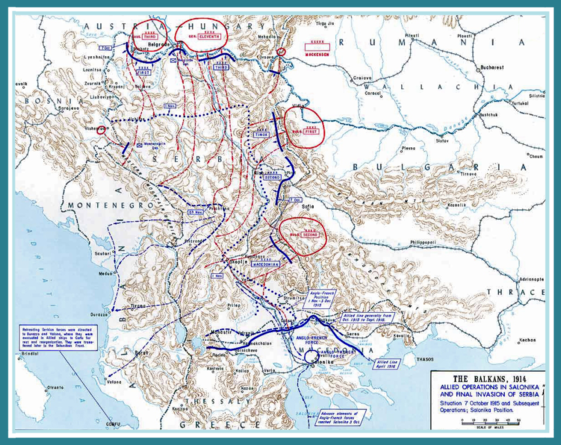
SalonikaN front, 1915/16.
There were a number of Irish infantry units involved in the Salonikan/Macedonian campaigns, which lasted from October 1915 to November 1918.
October 1915.
10th (Irish) Division arrived from Gallipoli in October 1915.
The Division left for Palestine in September 1917.
November 1915 onwards.
Arriving from France.
1st Bttn, Leinster Regiment - 82nd Infantry Brigade, 27th Division.
Transferred to 29th Brigade, 10th (Irish) Division in November 1916.
Left for Palestine with the Division in September 1917.
2nd Bttn, Royal Irish Fusiliers - 82nd Infantry Brigade, 27th Division.
Transferred to 31st Brigade, 10th (Irish) Division in November 1916.
Left for Palestine with the Division in September 1917.
1st Bttn, Royal Irish Regiment - 82nd Infantry Brigade, 27th Division.
Transferred to 30th Brigade, 10th (Irish) Division in November 1916.
Left for Palestine with the Division in September 1917.
December 1916.
Arrived from France.
2/18th Bttn, London Regiment (London Irish Rifles) - 141st Brigade, 60th (London) Division TF.
The Division left for Palestine during June 1917.
The possibility of sending Allied forces to the help of Serbia had been considered since early 1915 – but how? Even though Greece might have been a potential ally, the pro German monarchs of both Greece and Bulgaria were greatly influenced by the Allied breakdown in the Dardanelles and the failure of the Isonzo. Bulgaria declared war on Serbia on 6th September 1915 and took the hard pressed Serbian Army (heavily attacked by the Germans as well as the Austrians) in the rear, cutting communications with Salonika.
The sad end to a brave fight by the Serbians was to retreat into Albania, whence Allied shipping brought the remnants to the Macedonian front.
In a belated attempt to succour Serbia, with troops released from Gallipoli, the first French and British troops began to land at Salonika on 5th October. The French were particularly keen on the Salonika enterprise – partly for political reasons of their own (to give employment to Sarrail, the Republican general dismissed by Joffre).
By the 27th, the French had advanced some way up to the Vardar Valley, but the Bulgarians had cut off the main Serbian forces. General Mahon, with his 10th (Irish) Division and some other troops – owing to uncertainty over the Greeks – was not allowed to move forward immediately as requested by Sarrail. Once more, 10th (Irish) Division who, in the Gallipoli peninsula had never fought as a division, had been hurriedly moved to a new theatre of war; at least, their supporting arms and services, incomplete at Suvla, were partly made up.
When 5th Connaught Rangers landed at Salonika, their fifes and drums made a good impression when “Killaloe” was followed by the “Marseillaise”; the French officers saluted the Rangers' green flag, a poilu embraced the drum major and everyone cheered. Of the doubtful delights of Salonika, it was said, “even the women of pleasure were the very last reserves of the Army of Aphrodite.”
Source: "A History of the Irish Soldier", Brigadier AEC Bredin DSO MC DL.


